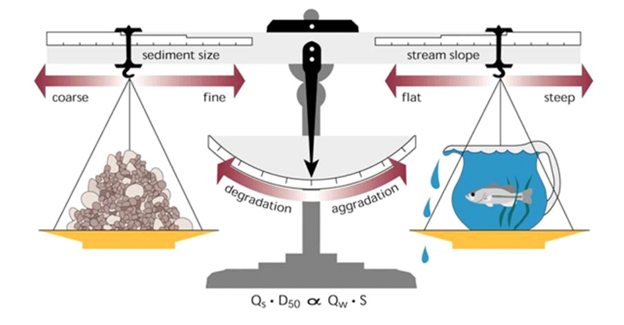The term “Lane’s Scale” will be the target that I am going to define in this assignment. The main goal for this post is to give a brief introduction in three types of definitions to those audience with non-technical background and fresh to this term. The situation will be set as a fourth-year university student who is giving a presentation based on his knowledge and experience from previous course to a group of students graduated from high school and are planning to major in environmental science.
Term to be defined: Lane’s Scale
Parenthetical definition: A representative model of fluvial geomorphology.
Sentence definition: The Lane’s scale (also refers to Lane’s balance) is a model introduced from fluvial geomorphology. It applies to describe the balance between the load of water and the sedimentation within a stream system. As well as demonstrating the process (channel aggradation/degradation) that the system tends to go through by self-adjusting those elements show on the scale to maintain the balance.
Expanded definition:
Lane’s scale (Lane’s balance) is a useful model to study and understand the channel equilibrium. It really tells us a lot about how a stream system will adjust by itself. Whatever you are doing your research in the river restoration or river engineering field and suchlike, it tells you the fundamental concept about the relationship between water and sediments in a stream system.
History
The model of Lane’s scale first came from the concept of Lane’s relation which was introduced by E. W. Lane in 1955 (Lane, E. W., 1955). He introduced the qualitative expression which included the relationship between water discharge, sediment discharge or load, channel slope, and the representative sediment size for a river under a dynamic equilibrium condition (Dust & Wohl, 2011).
Operating Principle
It has been displayed on the model that on one side we got sediments and water on the other. If the sediments side goes down, that will lead to the aggradation to the channel bed. And if the water side goes down, it will lead to the degradation to the channel bed. This is a kind of local reach adjustment.
Visuals
Figure 1. Model of Lane’s Balance (University of Kentucky, 2014)
In terms of water and sediments, the certain amount of water discharge that should happen in equilibrium with the sediment supply and the whole system should be balance. That means river is able to adjust over a period of time by the discharge and sediments which related to the channel geometry. The relative process and their causing elements are shown as below:
- Aggradation (deposition)
- Coarsening sediment size
- More sediment input
- Less sediment output
- Stream slope decrease
- Water discharge decrease
- Degradation (erosion)
- Fining sediment size
- Less sediment input
- More sediment output
- Stream slope increase
- Water discharge increase
Examples
The equilibrium is dynamic. For example, the water input can be dramatically increased when there is a storm comes through, and this can be reflected on the balance that the water will get loss at the bottom of water side as the water in the container is getting flood over. Depending on the water input and loss in a river system, those sides of the balance can go up and down. This is the dynamic equilibrium driven by the hydrology which is first started prior to the runoff process. After that, the runoff from upstream may lead to the channel or bank erosion and landslide input which are going to increase the amount of sediments. If it is unavailable to get rid of the sediments, the sediment is going to pile up as it reflected on the other side of the balance which makes it goes down, then results in a channel aggradation at the end.
Reference:
Lane, E. W., 1955. The importance of fluvial morphology in hydraulic engineering. Proceedings, American Society of Civil Engineers, No. 745, July.
Dust, D., & Wohl, E. (2011, October 14). Conceptual model for complex river responses using an expanded Lane’s relation. Retrieved June 06, 2020, from https://www.sciencedirect.com/science/article/abs/pii/S0169555X11005241
University of Kentucky, Arts & Sciences. (2014). Retrieved June 06, 2020, from https://www.as.uky.edu/blogs/jdp/changing-lanes

Leave a Reply